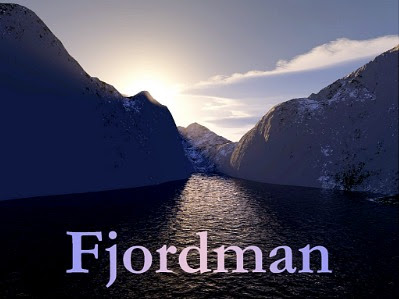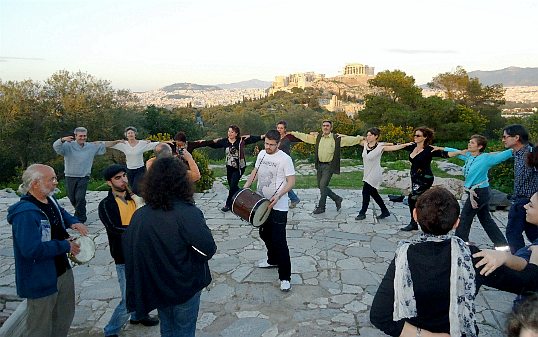If you appreciate this essay by Fjordman, please consider making a donation to him, using the button at the bottom of this post.

Fjordman Travel Files: My Visit to Greece
As I have briefly mentioned before at this blog, I took a trip from Jerusalem via Athens to Rome earlier this year. I’ve been to both Jerusalem and Rome several times in the past, but this was my first visit to Greece. I don’t think it will be my last; there are so many things to see.

Greeks singing and dancing just before sunset
Yes, I did notice social tensions and strikes due to the economic crisis in the eurozone. I also saw some native beggars in the streets who were not drug addicts, but simply poor. This is rare in the Scandinavian countries, but unfortunately not an uncommon sight in Greece today.
Furthermore, as in many other European cities, Athens clearly has problems with mass immigration, illegal or otherwise, from Africa and the Islamic world. I will say more about this later.
I initially had plans to go to Crete and some of the other Greek islands, but sadly didn’t have time this trip. I decided to do Athens properly instead of seeing very little at many different sites.
However, I did do some traveling around mainland Greece. Among the highlights were visits to Delphi, where the famous oracle once was, Olympia, where the original Olympic Games were held as far back as in the eighth century BC, as well as beautiful Meteora.

The Acropolis at night, Athens
For a visiting Norwegian, there are a few obvious similarities between Norway and Greece. The tallest mountains in Europe are found in the Alps, such as Mont Blanc or Monte Bianco (“White Mountain”) at the border between France and Italy, 4,810 meters high, and in the far southeastern fringes of Europe represented by Mount Elbrus in the Caucasus mountain range at 5,642 meters.
By comparison, the highest mountain in Greece is the famous Mount Olympus at 2,917 meters, whereas the highest mountain in Norway is Galdhøpiggen at a relatively modest 2,469 meters. You can easily see bigger and more majestic mountains than that in Switzerland or Austria. Yet while these are rightfully thought of as “Alpine” countries, there are still larges sections of those countries that are not covered by mountains.
You will not see any mountains at all from Vienna, for instance, just a few hills in the Vienna Woods (Wienerwald) outside the city. You are much closer to the mountains in other Austrian cities such as Salzburg, though, where they affect the local weather patterns. Innsbruck has the unusual distinction of being a university city where within a few minutes from the city center you can reach the top of an Alpine mountain.
Yet when it comes to how big a percentage of the area is covered by mountains, some of the top countries in Europe are Norway, Albania and Greece, in addition to micro-states such as Andorra in the eastern Pyrenees, between Spain and France.
A major proportion of Greece’s present-day population of nearly eleven million people live in or around just two cities, Athens and Thessaloniki. Athens is bigger and more dominant in Greek life than Oslo is in Norway.
However, both countries have large areas that are hilly and sparsely populated. Norway and Greece have very long coastlines, too, with a tradition of seafaring and exploration that is continued in modern shipping. Fish farms and modern aquaculture are also common sights in both nations.

Inside the Acropolis Museum
While Greece has a few places that might resemble them, it does not have the spectacular Norwegian fjords. On the other hand, the hundreds of Greek islands are magnificent in their own right. You can engage in an island hopping of sorts in the archipelago of Lofoten in northern Norway, but this does not quite match Santorini, Kos, Samos, Rhodes or Crete.
A major difference is, of course, the climate. You will not generally see lemon trees or orange trees in gardens in Scandinavia, but you will in Italy, Spain, Portugal or Greece. Obviously, the Mediterranean region also has a very long tradition for growing olives and grapes. Apart from a few examples with limited success in southern Scandinavia, you cannot find vineyards in the Nordic region; it is quite simply too cold for that.
Our knowledgeable Greek guide was a lady called Anastasia. Many people think this is a Russian name, but it was in fact something which the Russians and others Orthodox peoples in Eastern Europe borrowed from Greek Orthodox Christians when they received Christianity and literacy via the Byzantine Empire. At the same time, they also imported male Slavic names such as Dmitri derived from the Greek name Demetrius.
From the opposite end of Europe, the Scandinavian Vikings, especially from Sweden, went down the rivers in Eastern Europe and founded the first Russian state. They brought with them other Germanic names such as Helga (Olga) and Ingvar (Igor) that are common in some of the Slavic languages to this day.

DONATE TO FJORDMAN:
For a complete archive of Fjordman’s writings, see the multi-index listing in the Fjordman Files.
